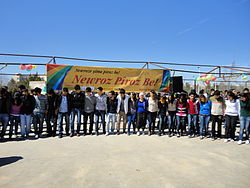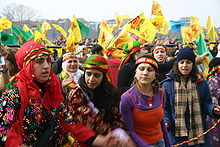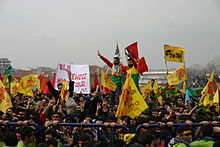| Revision as of 05:31, 24 May 2014 editLouisAragon (talk | contribs)Autopatrolled, Extended confirmed users, Pending changes reviewers, Rollbackers71,887 edits Fixed article according the Nowruz article.Tag: Mobile edit← Previous edit | Revision as of 05:36, 24 May 2014 edit undoLouisAragon (talk | contribs)Autopatrolled, Extended confirmed users, Pending changes reviewers, Rollbackers71,887 edits There was no Kurdish identity 2,500 years ago. Every Kurd knows this. Also the constant comparisons with Europe and Christianity make it sound very wannabe-ish (as in PoV)Tag: Mobile editNext edit → | ||
| Line 11: | Line 11: | ||
| ===Death of Dehak and spring=== | ===Death of Dehak and spring=== | ||
| According to Kurdish myth, Kaveh |
According to Kurdish myth, Kaveh lived 2,500 years ago under the tyranny of Zahak, an ]n who is named Zuhak by the Kurds.<ref name="murphy" /><ref>{{cite web | url = http://www.institutkurde.org/en/publications/bulletins/bulletins.php?bul=192 | title =Newroz 2001: In Diyarbekir the celebrations brought together 5000000 people in a calm atmosphere, but there were many incidents in Istanbul | accessdate = 2007-03-13 | date = March 2001 | author = Kurdish Institute of Paris}}</ref> Zuhak's evil reign caused spring to no longer come to ].<ref name="murphy" /> March 20 is traditionally marked as the day that Kawa defeated Dehak. He is then said to have set fire to the hillsides to celebrate the victory and summon his supporters; subsequently spring returned to Kurdistan the next day.<ref name="murphy" /> | ||
| In some of the present Kurdish versions of the story of Zahhak and Kawa, there is no mention of '']''.<ref name=autogenerated2 /> Although in the ] (Yarsan) Kurdish tradition, Kawa rebelled against Zahak and helped Fereydun bound Zahak in Damavand.<ref>Hajj Nematollah, Shah-Nama-Ye Haqiqat, Intishaaraat Jeyhun, (1982).</ref> | In some of the present Kurdish versions of the story of Zahhak and Kawa, there is no mention of '']''.<ref name=autogenerated2 /> Although in the ] (Yarsan) Kurdish tradition, Kawa rebelled against Zahak and helped Fereydun bound Zahak in Damavand.<ref>Hajj Nematollah, Shah-Nama-Ye Haqiqat, Intishaaraat Jeyhun, (1982).</ref> | ||
| Line 17: | Line 17: | ||
| This legend is now used by the Kurds to remind themselves that they are a different, strong people, and the lighting of the fires has since become a symbol of freedom.<ref name="murphy" /> | This legend is now used by the Kurds to remind themselves that they are a different, strong people, and the lighting of the fires has since become a symbol of freedom.<ref name="murphy" /> | ||
| Connecting new year ’s day celebration with injustice and oppression is also reflected in the ] celebration of ], whose chronology begins when ], became ]. In the 1930s, the Kurdish poet ''Taufik Abdullah'', wanting to instil a new Kurdish cultural revival, used a previously known modified version of the story of Kawa.<ref name="murphy"/> He connected the myths where people felt oppressed with Newroz, thus reviving a dying holiday and making it a symbol of the Kurdish national struggle.<ref name="murphy" /> However, it should be noted that Kurds celebrated ''Newroz'' long before this, and the word ''Newroz'' was mentioned in Kurdish poetry from the 16th century. The arrival of spring has been celebrated in Asia Minor since neolithic times |
Connecting new year ’s day celebration with injustice and oppression is also reflected for example in the ] celebration of ], whose chronology begins when ], became ]. In the 1930s, the Kurdish poet ''Taufik Abdullah'', wanting to instil a new Kurdish cultural revival, used a previously known modified version of the story of Kawa.<ref name="murphy"/> He connected the myths where people felt oppressed with Newroz, thus reviving a dying holiday and making it a symbol of the Kurdish national struggle.<ref name="murphy" /> However, it should be noted that Kurds celebrated ''Newroz'' long before this, and the word ''Newroz'' was mentioned in Kurdish poetry from the 16th century. The arrival of spring has been celebrated in Asia Minor since neolithic times. | ||
| ==Newroz customs and celebration== | ==Newroz customs and celebration== | ||
Revision as of 05:36, 24 May 2014
This article is about the celebrating the Persian feast of Nowruz. For the main article, see Nowruz.
Newroz or Nawroz (Template:Lang-ku, also: Gulus Template:Lang-ku) refers to the celebration of the traditional Persian new year holiday of Newroz in Kurdish society. The festival of Newroz is celebrated throughout the countries of the Middle East, Caucasus, and Central Asia, such as in Iran, Kurdistan, Azerbaijan and Afghanistan. Newroz is also celebrated by some communities in Europe, and wider South Asia. In Kurdish legend, the holiday celebrates the deliverance of the Kurds from a tyrant, and it is seen as another way of demonstrating support for the Kurdish cause. The celebration coincides with the Northward equinox which falls mainly on 21 March and the festival is held usually between 18 and 24 March. The festival currently has an important place in the terms of Kurdish identity for the majority of Kurds, mostly in Turkey and Syria. Though celebrations vary, people generally gather together to welcome the coming of spring; people wear coloured clothes and dance together.
Mythology
Story of Zahak
In General History by Dinawari, The Meadows of Gold by Muslim historian Masudi, and Shahnameh, a poetic opus written by the Persian poet Ferdowsi around 1000 AD, and Sharafnameh by the medieval Kurdish historian Sherefxan Bidlisi, Zahhak was an evil king who conquered Iran and had serpents growing from his shoulders. Zahak's rule lasted for one thousand years. During this time, two young men were sacrificed daily and their brains were offered to Zahhak's serpents in order to alleviate his pain. However, the man who was in charge of sacrificing the two young men every day would instead kill only one man a day and mix his brains with that of a sheep in order to save the other man. As discontent grew against Zahhak's rule, a nobleman planned a revolt led by Kaveh (also known as Kawa), a blacksmith (cf. Ossetian Kurdalægon), who had lost six sons to Zahhak. The young men who had been saved from the fate of being sacrificed (who according to the legend were ancestors of the Kurds) were trained by Kaveh into an army that marched to Zahhak's castle where Kaveh killed the king with a hammer. Eventually Kaveh was instated as the new Fereydun king. The root of this story goes back to ancient Iranian legends. According to Evliya Çelebi, the district (sancak) of Merkawe in Shahrazur (Sharazur) is named after Kaveh. The 12th century geographer Yaqoot Hamawi, mentions Zor son of Zahhak (Aji Dahak) as founder of the famous city of Sharazor.

Death of Dehak and spring
According to Kurdish myth, Kaveh lived 2,500 years ago under the tyranny of Zahak, an Assyrian who is named Zuhak by the Kurds. Zuhak's evil reign caused spring to no longer come to Kurdistan. March 20 is traditionally marked as the day that Kawa defeated Dehak. He is then said to have set fire to the hillsides to celebrate the victory and summon his supporters; subsequently spring returned to Kurdistan the next day.
In some of the present Kurdish versions of the story of Zahhak and Kawa, there is no mention of Fereydun. Although in the Ahl-e Haqq (Yarsan) Kurdish tradition, Kawa rebelled against Zahak and helped Fereydun bound Zahak in Damavand.
This legend is now used by the Kurds to remind themselves that they are a different, strong people, and the lighting of the fires has since become a symbol of freedom.
Connecting new year ’s day celebration with injustice and oppression is also reflected for example in the Coptic celebration of Nayrouz, whose chronology begins when Diocletian, became Roman emperor. In the 1930s, the Kurdish poet Taufik Abdullah, wanting to instil a new Kurdish cultural revival, used a previously known modified version of the story of Kawa. He connected the myths where people felt oppressed with Newroz, thus reviving a dying holiday and making it a symbol of the Kurdish national struggle. However, it should be noted that Kurds celebrated Newroz long before this, and the word Newroz was mentioned in Kurdish poetry from the 16th century. The arrival of spring has been celebrated in Asia Minor since neolithic times.
Newroz customs and celebration
Newroz is considered the most important festival in Kurdish culture, and is a time for entertainment such as games, dancing, family gathering, preparation of special foods and the reading of poetry. The celebration of Newroz has its local peculiarities in different regions of Kurdistan. On the eve of Newroz, in southern and eastern Kurdistan, bonfires are lit. These fires symbolize the passing of the dark season, winter, and the arrival of spring, the season of light. The 17th century Kurdish poet Ahmad Khani mentions in one of his poems how the people, youth and elderly, leave their houses and gather in countryside to celebrate Newroz.
Political overtones




The Kurdish association with Newroz has become increasingly pronounced since the 1950s when the Kurds in the Middle East and those in the diaspora in Europe started adopting it as a tradition. Following the persecution the Kurds suffered in Turkey, the revival of the Newroz celebration has become more intense and politicized and has also become a symbol of the Kurdish resurrection. By the end of the 1980s, Newroz was mainly associated with the attempts to express and resurrect the Kurdish identity.
While the Kurdish celebration has taken the form of a political expression in Turkey, most Kurdish celebrations in Iran are identical to the national festivals. Izady states that the reason for this may be that the original tradition and folklore behind Newroz has been lost in the northern and western parts of Kurdistan (i.e. Turkey), where it never evolved in the same way as in the southern and eastern parts. Izady further states that Newroz might have gained prominence in the northern and western parts because of the prominence of the celebrations that the staunchest Kurdish adherents of Newroz, the Iraqi and Iranian Kurds, have enjoyed through their more frequent popular uprisings. Thus the western and northern Kurds seem to perceive the celebration of the new year as a unifying political expression.
In 2000, Turkey legalized the celebration of the spring holiday, spelling it Nevruz and claiming it as a Turkish spring holiday. Also, using the Kurdish spelling Newroz rathern than Nevruz, has been officially forbidden, though it is still widely used by Kurds. In the Kurdish regions of the country, specifically in Eastern Anatolia, but also in Istanbul and Ankara where there is a large Kurdish population, people gather and jump over bonfires. Previous to it being legalized, the PKK, the Kurdistan Workers’ Party, had chosen the date of the Newroz festival to stage attacks to obtain publicity for their cause; this led to Turkish forces detaining thousands of people who were seen as supporters of the Kurdish rebel movements. During the Newroz celebrations of 1992, more than 50 Kurdish participants were killed by Turks. Also in 2008, two participants were killed.
In Syria, the Kurds dress up in their national dress and celebrate the new year. According to Human Rights Watch, the Kurds have had to struggle to celebrate Newroz, and in the past the celebration has led to violent oppression, leading to several deaths and mass arrests. The government has stated that the Newroz celebrations will be tolerated as long as they do not become political demonstrations of the treatment of the Kurds. During the Newroz celebrations in 2008, three Kurds were shot dead by Syrian security forces.
Kurds in the diaspora also celebrate the new year; for example Kurds in Australia celebrate Newroz, not only as the beginning of the new year but also as the Kurdish National Day; and the Kurds in Finland celebrate the new year as a way of demonstrating their support for the Kurdish cause. Also in London, organizers estimated that 25000 people celebrated Newroz during March 2006.
Newroz in Kurdish literature
Newroz has been mentioned in works of many Kurdish poets and writers as well as musicians. One of the earliest records of Newroz in Kurdish literature is from Melayê Cizîrî (1570–1640):
- Without the light and the fire of Love,
- Without the Designer and the power of Creator,
- We are not able to reach Union.
- (Light is for us and dark is the night)
- This fire massing and washing the Heart,
- My heart claim after it.
- And here come Newroz and the New Year,
- When a such light is rising.
Also the famous Kurdish writer and poet Piramerd (1867–1950) writes in his 1948 poem Newroz:
- The New Year's day is today. Newroz is back.
- An ancient Kurdish festival, with joy and verdure.
- For many years, the flower of our hopes was downtrodden
- The fresh rose of spring was the blood of the youth
- It was that red colour on the high horizon of Kurd
- Which was carrying the happy tidings of dawn to remote and near nations
- It was Newroz which imbued the hearts with such a fire
- That made the youth receive death with devoted love
- Hooray! The sun is shining from the high mountains of homeland
- It is the blood of our martyrs which the horizon reflects
- It has never happened in the history of any nation
- To have the breasts of girls as shields against bullets
- Nay. It is not worth crying and mourning for the martyrs of homeland
- They die not. They live on in the heart of the nation.
See also
References
- Thomas Bois, Connaissance des Students, 164 pp., 1965. (see p.69)
- Abdurrahman Sharafkandi (Hejar), Henbane Borîne (Kurdish-Kurdish-Persian Dictionary), Soroush Press, 1991, Tehran, p. 715
- ^ Murphy, Dan (2004-03-24). "For Kurds, a day of bonfires, legends, and independence". The Christian Science Monitor. Retrieved 2007-03-08.
- ^ Yanik, Lerna K. (March 2006). "'Nevruz' or 'Newroz'? Deconstructing the 'Invention' of a Contested Tradition in Contemporary Turkey". Middle Eastern Studies. 42 (2): pp. 285–302. doi:10.1080/00263200500417710.
{{cite journal}}:|pages=has extra text (help) - ^ Izady, Mehrdad R. (1992). The Kurds: A Concise Handbook. Washington, D.C.: Taylor & Francis. pp. 243–244. ISBN 0-8448-1727-9.
- ^ Jupp, James (2001). The Australian People: An Encyclopedia of the Nation, its People and their Origins. Cambridge: Cambridge University Press. ISBN 0-521-80789-1.
- ^ Yildiz, Kerim (2004). The Kurds: Culture and Language Rights. Kurdish Human Rights Project. ISBN 1-900175-74-6.
{{cite book}}: Unknown parameter|coauthors=ignored (|author=suggested) (help) - Wahlbeck, Osten (1999). Kurdish Diasporas: A Comparative Study of Kurdish Refugee Communities (Migration, Minorities and Citizenship). Basingstoke: Macmillan. ISBN 0-312-22067-7.
- "Newroz - Kurdish New Year". BBC.
- Frantz, Douglas (2001-03-23). "Diyarbakir Journal: Where Misery Abounds, the Kurds Make Merry". The New York Times. Archived from the original on 2007-02-16. Retrieved 2007-03-08.
- Macris, Gina (2002-03-25). "Kurds Ring in New Year". Providence Journal. Archived from the original on 2006-12-17. Retrieved 2007-03-08.
- ^ al-Dinawari, Ahmad b. Dawud. Kitab al-akhbar al-tiwal. Edited by V.Guirgass. Leiden. 1888, see p. 7
- ^ Hakan Ozoglu, Kurdish notables and the Ottoman State, 2004, SUNY Press, page: 30. ISBN 0-7914-5993-4
- ^ Warner, Marina (2004). World of Myths: Roman Myths. University of Texas Press. ISBN 0-292-70607-3.
{{cite book}}: Unknown parameter|coauthors=ignored (|author=suggested) (help) - 05001 Zahak
- ^ Martin van Bruinessen, "Kurdistan in the 16th and 17th centuries, as reflected in Elviya Çelebi's Seyahatname", The Journal of Kurdish Studies, Vol. 3, pp.1-11, 2000.
- Kitab Mu'jam Al Buldan by Yaqoot Hamawi, Book 3, p: 425-427
- Kurdish Institute of Paris (March 2001). "Newroz 2001: In Diyarbekir the celebrations brought together 5000000 people in a calm atmosphere, but there were many incidents in Istanbul". Retrieved 2007-03-13.
- Hajj Nematollah, Shah-Nama-Ye Haqiqat, Intishaaraat Jeyhun, (1982).
- ^ Festivals: Kurdish, in Encyclopædia Iranica, by KEITH HITCHINS
- "Kurds and No Way". SchNEWS. 2005-05-06. Retrieved 2007-03-10.
- Bianet :: Let Newroz and Nevruz bring Peace and Spring!
- "Turkish police arrest thousands". BBC. 1999-03-22. Retrieved 2007-03-10.
- "Two demonstrators die in Turkey clashes". RTÉ News. 2008-03-23.
- Kreyenbroek, Philip G. (1991). The Kurds. Routledge. ISBN 0-415-07265-4.
{{cite book}}: Unknown parameter|coauthors=ignored (|author=suggested) (help) - Amnesty International (2004-03-16). "Syria: Mass arrests of Syrian Kurds and fear of torture and other ill-treatment". Amnesty International. Archived from the original on 2006-11-19. Retrieved 2007-03-10.
- Three Kurds killed in Syria shooting, human rights group says - Middle East
- "Police kill three Kurds in northeast Syria - group". Reuters. 2008-03-21.
- Wahlbeck, Osten (1999). Kurdish Diasporas: A Comparative Study of Kurdish Refugee Communities. Palgrave Macmillan. ISBN 0-312-22067-7.
- "London celebrates Newroz: The Kurdish New Year". The Londoner. March 2006. Retrieved 2007-03-10.
- van Bruinessen, Martin (2000). "Transnational aspects of the Kurdish question". Florence: Robert Schuman Centre for Advanced Studies, European University Institute.
- ^ Alexie, Sandrine (2007-03-21). "Newroz û Sersal (Newroz and New Year)". Roj Bash. Retrieved 2007-03-22. Cite error: The named reference "poem" was defined multiple times with different content (see the help page).
External links
- Festivals: Kurdish, in Encyclopædia Iranica, KEITH HITCHINS
- Where Misery Abounds, the Kurds Make Merry
- Newroz for Kurds, a day of bonfires, legends, and independence
- Kawa and the Story of Newroz, By Mark Campbell
- Newroz and Kurds (a good academic sources on Kurds)
- Newroz 2008 in Mahabad (Iranian Kurdistan), BBC photo
| Kurdish culture | |
|---|---|
| Nowruz | |
|---|---|
| Traditions | |
| Part of | |
| Related | |
| Variations | |